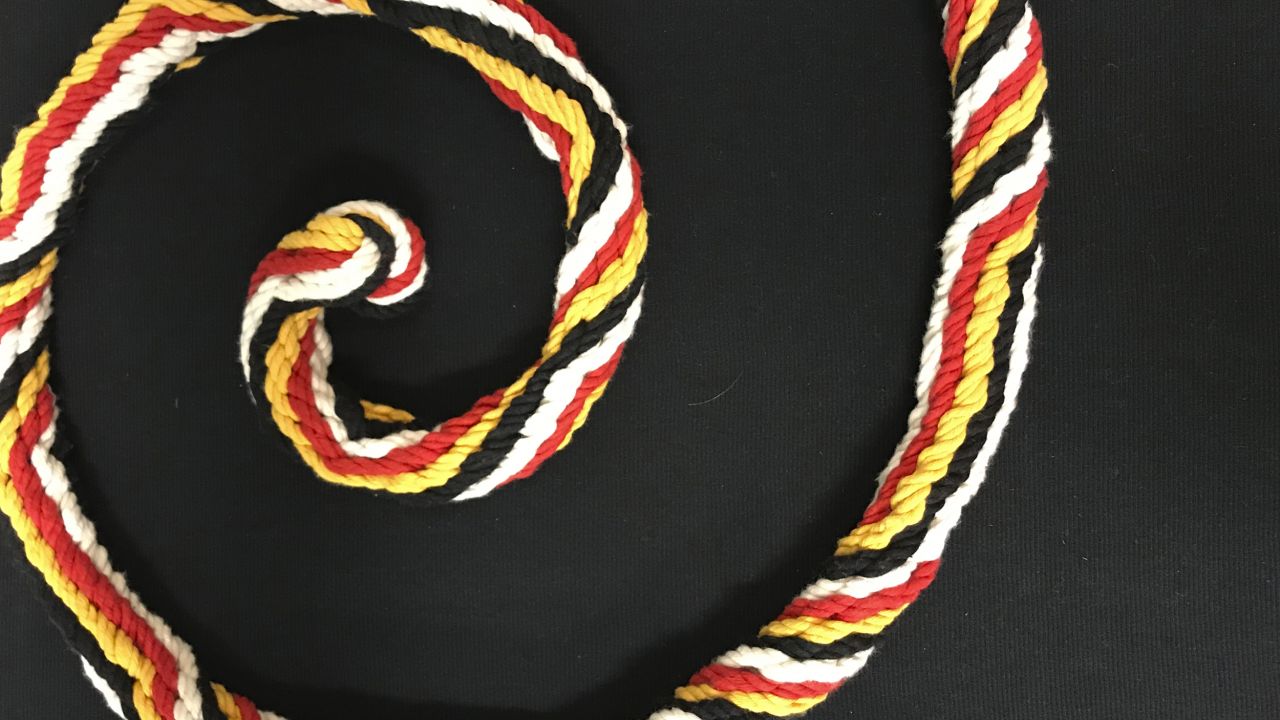
Hands-on History: A Community Experiment to Re-create a Lost Inca Rope is a participatory effort to re-create the largest textile of the pre-modern world.
Hands-on History: A Community Experiment to Re-create a Lost Inca Rope is a communal effort to recreate the largest textile of the premodern world. It materially grounds Marini's dissertation in art history by enlisting the community to co-construct a 1/3 scale model of a destroyed, 900-foot, gold-plated, wool rope. The rope permeated the visual landscape of the Inca empire of South America in the early sixteenth century and was activated in Inca imperial rituals. Guided by Marini's research in Inca and Quechua rope braiding, participants joined in an experiment to make this rope and thereby gauge the process and labor required to create the full-size original that has no surviving representations.
At the Woskob Family Gallery and Penn Museum, close to 60 participants rhythmically exchanged nearly 500-foot-long spools of red, yellow, white, and black cotton yarn to braid a pattern matching the Inca rope's written description. The pattern is upscaled from a handheld, zigzag braid displayed in the gallery. The replicated braid, however, is monumental. As we worked, our measured progress confirmed that an entire community would need to devote all of their energy for approximately one month just to braid a rope of this size in its entirety. A follow-up workshop adhering golden disc appliqués to the completed portion further demonstrated the need for various craft specialists and significantly more time and resources for the rope's embellishment. This phase offered a glimpse into how a textile of this size would have appeared when handled in an imperial ritual by an alleged 200 performers the night before, and upon the dawn of the summer solstice. With our model, we were able to emulate how light morphed the rope's appearance on the solstice when the rising sun refracted off of its body at the culmination of its kinetic engagement.
This visual effect is recreated in the gallery space with spotlights that shine on the rope. The rope is installed slithering on the gallery wall, mounted as a two-dimensional object to convey how it was enshrined wrapped around the ceiling of an Inca chapel in its dedication; it then enters a third dimension as it unravels from its sixteen-strand core and cascades across the ceiling, and then back to the opposite wall where gravity then pulls it to the ground. The individual cords draw attention to the four hues that comprise it and convey that the rope is a material embodiment of the rainbow as the Incas had intended. Our remaking and installation of the rainbow rope presents a social space for anyone to experientially partake in art historical research. Through the process, we gain a dynamic understanding of Indigenous aesthetics as they intersected with Inca imperial theater.
Marini's artistic process is didactic and collaborative. He conceptually grounds his work in his art historical research. He then makes artworks informed by these deductions that help to visualize and prove the veracity of lost artworks recorded in textual sources. These recreations enable onlookers to witness and interact with the intended viewer experiences of destroyed objects. Marini's past solo exhibitions have included America's Social Fibers: Mobility and Migration in the Western Hemisphere before 1532 (2021–2), Glimpses of Ecuador (2018), and God, Gold and Glory (2016).
Bio
Kyle Marini is an artist and Ph.D. Candidate in art history at Penn State. He melds his creative work with his academic research in his effort to overcome the incomplete historic and material record of Andean textiles. His dissertation centers on an enormous rope sculpture that was annually processed in the foremost Inca solstice ritual. He is developing an interdisciplinary, hands-on research methodology that can recover the destroyed rope's construction, appearance, and visual impact across media to illuminate Inca modes of artistic representation. This approach, which he calls "experiential art history," is inherently participatory and community based. Apart from its public engagement, Kyle's art and research have been recognized by numerous internal and external agencies. His dissertation research has been funded by fellowships from Foreign Language and Area Studies, the Rhode Island Foundation, the McNeil Center for Early American Studies, the Marilynn and Carl Thoma Foundation, and Fulbright-Hays.